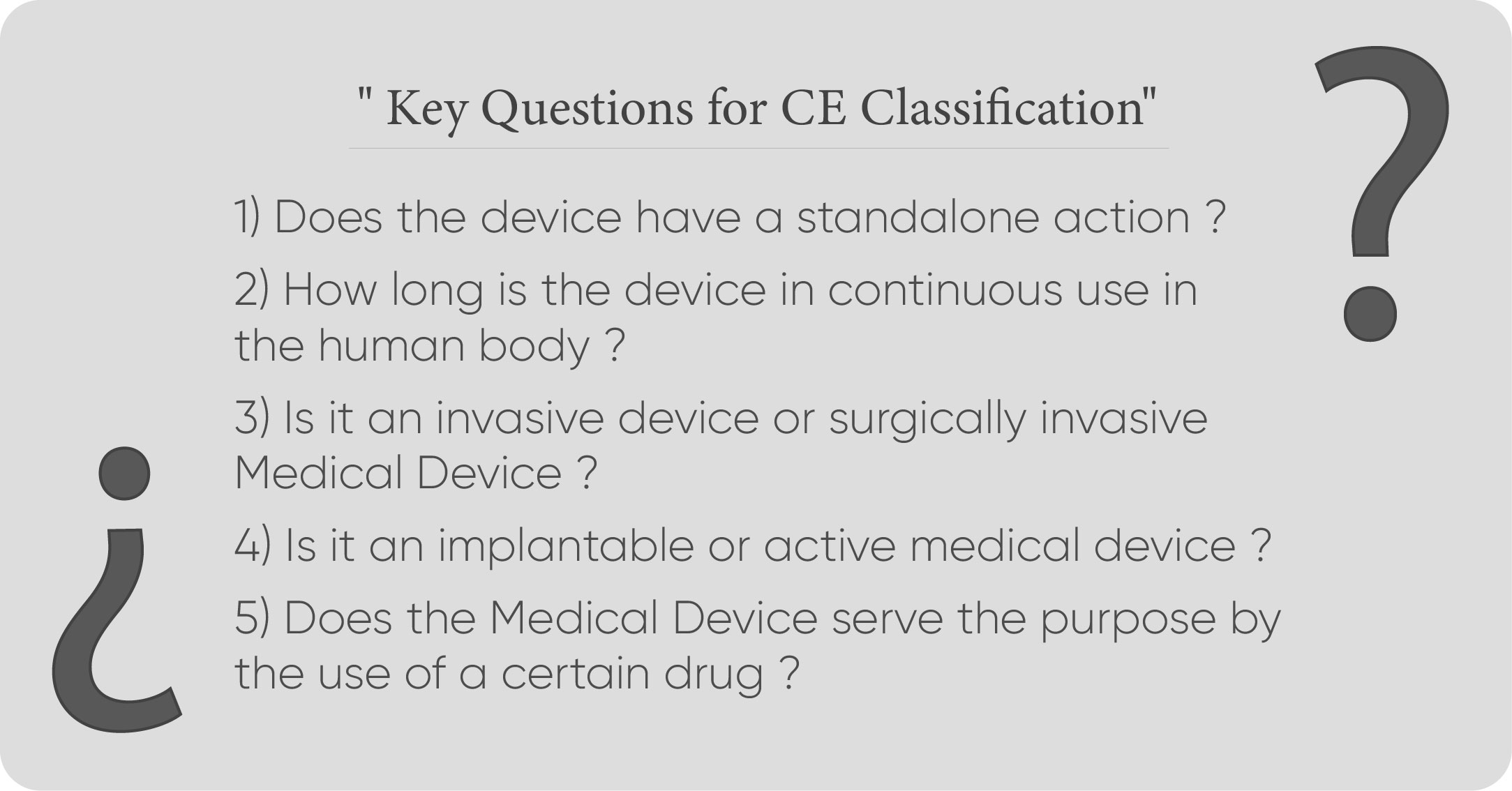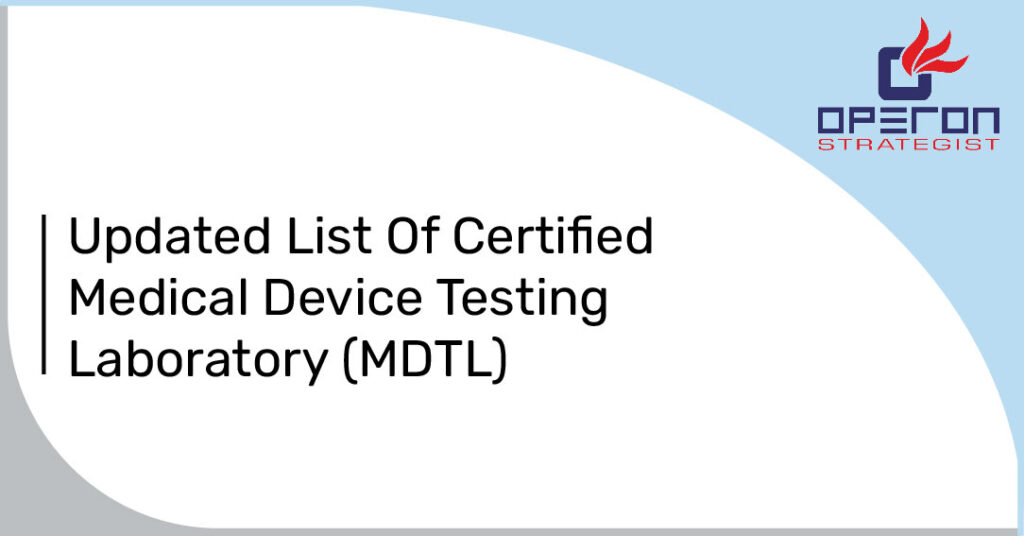The prerequisites for MDR classification for medical devices are basically equivalent to those in the present Medical Devices Directive (MDD). The EU MDR is shaking up the medical device industry and the order rules have not been left immaculate. The MDR decides the congruity assessment course for the device. While the order principally worries of the maker, if the device falls into Classes IIa, IIb, or III it has suggestions for the Notified body.
Before medical devices manufacturers can lawfully CE stamp their products in Europe, they should consent to the fitting medical devices order or guideline set out by the EU Commission. It is critical to know the right medical device classification for your product before CE marking your devices. CE marking is a conformity assessment of product which shows that the product is safe and effective as per the regulations. As CE mark medical device consultant we know that affixing CE mark to your product is necessary and impactful for the EU market. A classification impacts the administrative prerequisites for your devices, just as the endorsement course and its related expenses.
The number of rules in the MDR classifications has expanded from 18 to 22 and extra changes have been made to existing guidelines, which means numerous devices have new classifications. One of the important changes with the EU MDR is that medical device manufacturers will feel as they progress to conform to the new guideline is the adjustment in prerequisites for devices classifications. As medical devices classification change so do the prerequisites for manufacturers. The MDR will apply to specific products not directed through the MDD, such devices without an expected medical reason like non – corrective contact lenses.2 The MDR will likewise uncommonly manage devices joining nonmaterial\’s and devices fabricated with non – feasible human tissue, which are at present absolved from the MDD.
With new guidelines likewise come classifications changes significant to specific devices. All dynamic implantable devices and their accessories will be considered as Class III. Any substance-based devices expected to be utilized by means of a body orifice or applied on the skin may not be a class I, so any substance – based devices at present in class I will be up – classified with the new regulation. Any manufacturer with a device that will be up – classified with the MDR must consent to the stricter necessities and will probably need to draw in their body more. The MDR classification specifies that the products are specifically intended for the cleaning, disinfection or sterilization of medical devices.
EU MDR classifications for medical devices
One of the first considerations for medical devices manufacturers who are seeking to place their products in the European markets is to determine which the appropriate classifications for their devices are.
The MDR classification of the device will impact on how and when you will engage with your Notified Body. As the market transitions from Medical Devices Directives (MDD) and the Active Implantable Medical Devices to the Medical Devices Regulation, the device manufacturers must note the changes in the requirements for device classification. For example, devices that had previously been included in the Active Implantable Medical Device Directives (MDD) are now covered in the Medical Device Regulation (MDR).
Medical Device Classification as per MDR
As per MDR Article, 51 Medical Devices are divided into class I, IIa, IIb and class III, taking into account the intended purpose of the devices and their inherent risks. Medical Device classifications are mainly based on the following factors:
The Medical Devices Classification in the European Union new MDR is outlined in ANNEX VIII, Chapter I and classification Rule mentioned in Chapter III. This chapter includes definitions of the terminology used in the medical devices guidance document for the classification of Medical Device.
The Medical Device is classified into:
- Class I
- Class I Sterile
- Class I Measuring
- Class I Reusable
- Class IIa
- Class IIb
- Class III
EU MDR Medical Device Classification Rules
The Medical Device Classification EU rules, which are based on the vulnerability of the human body, should take into account the potential risks associated with the technical design and manufacture of the devices.
You’ll find all those rules on the Medical Device Regulation MDR 2017/745 Annex VIII
- Rule 1– Non-invasive devices
- Rule 2 – Non-invasive devices intended for channelling or storing (Which includes cells)
- Rule 3 – Non-invasive devices that modify the biological or chemical composition of blood, body-liquids, other liquids and cells
- Rule 4 – Non-invasive devices in contact with injured skin or mucous membrane
- Rule 5 – Devices invasive in body orifices
- Rule 6 – Surgically invasive devices for transient use
- Rule 7 – Surgically invasive devices for short term use
- Rule 8 – Surgically invasive devices for long term use and implantable (including any device administering medicinal products, surgical mesh or spinal disc)
- Rule 9 – Active therapeutic devices intended to exchange or administer energy
- Rule 10 – Active devices for diagnosis & monitoring, emit ionizing radiation
- Rule 11 – Software intended to provide information which is used to take decisions with diagnosis or therapeutic purposes (from class I to class III)
- Rule 12 – Active devices intended to administer and/or remove medicinal products, body-liquids or other substances
- Rule 13 – All other active devices
- Rule 14 – Devices incorporating a medicinal substance including human blood or plasma
- Rule 15 – Contraception or prevention of the transmission of sexually transmitted diseases
- Rule 16 – Specific disinfecting, cleaning and rinsing devices
- Rule 17 – Devices specifically intended for recording of diagnostic images generated by X-ray radiation
- Rule 18 – Devices utilizing non-viable tissues or cells of human origin or tissues of animal or derivatives.
Four new rules:
- Rule 19 – Devices incorporating or consisting of nonmaterial
- Rule 20 – Invasive devices with respect to body orifices to administer medicinal products by inhalation
- Rule 21 – Substances or of combinations of substances that are intended to be introduced into the human body via a body orifice or applied to the skin and that are absorbed
- Rule 22 – Active therapeutic devices with an integrated or incorporated diagnostic function which significantly determines the patient management.
Adjustments to the medical device classification system are not as problematic as those for IVDs yet will expect manufacturers to roll out some significant improvements. A large number of these progressions are a consequence of the old directives not considering the degree of the obtrusiveness and potential toxicity quality of certain devices. The MDR classifications of devices are into four classes: class I, class IIa, class IIb and class III. How they are classified relies upon 23 principles that think about their capacity, the risk to patients and the manufacturer’s intended use. There are a specific set of classification rules for four unique classes of medical devices: non-obtrusive, intrusive, dynamic and uncommon principles for inventive devices that incorporate different substances. Medical devices manufacturers ought to know that it is completely basic to classify these devices effectively from the earliest starting point as it directs the manufacturing prerequisites, clinical assessment and congruity evaluation. To ere in favor of alert, manufacturers should survey all present and future devices to guarantee consistence with the changed classification system. Our team of medical device regulatory consulting can helps you to classify your product and provide regulatory services as per the classification.

-
Operon Strategisthttps://operonstrategist.com/author/snehal/
-
Operon Strategisthttps://operonstrategist.com/author/snehal/
-
Operon Strategisthttps://operonstrategist.com/author/snehal/
-
Operon Strategisthttps://operonstrategist.com/author/snehal/





